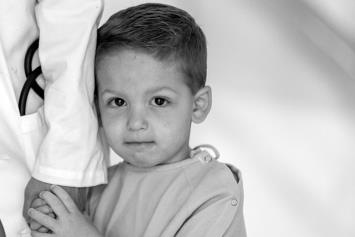Low-Grade Gliomas
Low-grade gliomas are a type of brain tumor that grow slowly and are less aggressive than high-grade gliomas. They can cause seizures, headaches, and other symptoms.
What Are Low-Grade Gliomas?
Low-grade gliomas are a type of tumor that form in the brain or spinal cord (central nervous system) because of abnormal growth of glial cells. Glial cells surround, protect and help neurons, the cells that send messages from your brain to the rest of your body. work properly.
There are four different types of glial cells:
- Ependymal cells
- Microglia
- Astrocytes
- Oligodendrocytes
Gliomas are classified into different tumor types based on which glial cells are involved and what part of the brain the tumor grows in.
Additionally, gliomas are categorized into four different grades. The grades are based on how fast the tumor grows and how aggressive the tumor cells appear under the microscope. Low-grade gliomas are tumors categorized as grades 1 or 2, because they are not very aggressive, are less likely to spread, and are slow-growing which makes them more treatable.
What Causes Low-Grade Gliomas?
Children with neurofibromatosis type 1, an genetic diseases that is passed down to offspring, have a higher risk of developing low-grade gliomas in the optic pathway, from the retina to the brain, and rest of the brain. However, there is no known cause for most other cases of low-grade gliomas. There is no evidence that external factors cause this type of tumor. Rather, researchers believe something is absent during normal development. Specifically, cells of the brain and spinal cord grow and separate as the body develops. During this cell division process, cells need to duplicate their genetic material. Errors can take place during this process, leading to mutations, which may allow cells to grow into tumors. These errors generally occur randomly and cannot be prevented.
What Are the Signs and Symptoms of Low-Grade Gliomas?
Your child’s symptoms can vary depending on the location and size of the tumor. Some of the more common symptoms that your child might experience include vison, hearing, communication and balance problems. Headaches are also common due to the increased pressure from the tumor, and they tend to be more painful in the morning and associated with nausea and vomiting.
Other symptoms include:
- one-sided weakness
- seizures
- unexplained weight loss or gain
- changes in behavior or personality
- increase in head size (in infants)
How Are Low-Grade Gliomas Diagnosed?
Your child's healthcare provider will ask about your child's health history and symptoms. The provider will do a physical exam and a neurological exam to test reflexes, muscle strength, eye and mouth movement and coordination. Your child's healthcare provider may refer your child to a cancer specialist (oncologist). Your child may need tests such as:
- CT Scan - A CT scan uses a series of X-rays and a computer to take pictures of the head or body. CT scans are very quick imaging, usually no more than a few minutes of scanning (though preparation may take longer).
- MRI - An MRI uses large magnets, radio waves and a computer to make detailed pictures of the body. Contrast dye may be injected into your child's vein. It helps tumors show clearly on the images. MRIs are very detailed imaging (provide much more information about the tumor), so take longer to perform (often 1-2 hours).
- Biopsy - Tumor cells are removed during surgery and sent to a lab for testing. This is done to find out the type of tumor (to finalize the tumor diagnosis) to determine how best to treat it and to understand how aggressive it is.
How Are Low-Grade Gliomas Treated?
Treatment for low-grade gliomas will be individualized for your child based on size, location and grade of the tumor. Your child’s treatment can include some or all of the following:
- Surgery - This is done to remove part or all of the tumor. More surgery may be needed over time if the tumor grows back. Surgery may be followed by chemotherapy or radiation therapy.
- Chemotherapy - These are medicines that kill cancer cells. One or more medicines may be given. Medicines may be oral or given through an IV or central line.
- Targeted Therapy - These are medicines (usually oral) used to target specific genetic alterations in the cancer cells and kill them.
- Radiation Therapy - These are high-energy X-rays or other types of radiation. They are used to kill cancer cells or stop them from growing.
- Clinical Trials - A clinical trial is a way to test new treatments for cancer. Ask your child's healthcare provider if there are any treatments being tested that may work well for your child. Many new treatments are only available in clinical trials.
- Supportive Care - Treatment can cause side effects. Medicines and other treatments can be used for pain, fever, infection, nausea and vomiting. This an important part of cancer care.
For most low-grade glioma, surgery can cure it if the whole tumor or the majority of the tumor is removed; in these cases, usually no additional treatment is needed. If the majority of the tumor cannot be removed safely, then your child may be treated with chemotherapy, targeted therapy, or radiation, depending on the tumor location, tumor testing results, and the patient’s age. All patients will be followed closely and have routine MRI scans to check for new tumor growth.
A child may have short- and long-term problems from the tumor or from treatment. They may include things such as:
- Damage to the brain or nervous system that causes problems with coordination, muscle strength, speech or eyesight
- Problems after surgery, such as infection, bleeding and problems with general anesthesia
- Increased risk of infection and bleeding from chemotherapy
- Delayed growth and development
- Learning problems
- Problems with reproduction (infertility)
- Return of the cancer (recurrence)
- Increased risk for other cancers later in life
Talk with the doctor about what you should watch for and what can be done to help prevent complications.
Survivorship – Outcomes and Life After Low-Grade Glioma Treatment
Improving the quality of life of survivors of low-grade gliomas is an area of much ongoing research and continued progress. Some patients have little to no long-term problems from their tumor or treatment, whereas other patients experience more significant side effects. All patients will continue to be followed by the oncology team after finishing treatment to ensure they are doing well and to offer appropriate resources, therapies, and subspecialty team services as needed. Patients will also continue to get surveillance imaging (MRIs) to ensure their tumor does not grow back; as the time from end of treatment increases, these scans will be spaced further apart.
Why Choose Nationwide Children’s Hospital?
The Neuro-Oncology Program at Nationwide Children’s Hospital offers clinical excellence in treating children, adolescents, and young adults with brain and spine tumors. Patients and their families will be supported by a multi-disciplinary team of providers, all dedicated to ensuring that the patient has the best possible outcomes. Depending on the specific tumor diagnosis and treatment plan, the patient and their family will be cared for by oncologists, neurosurgeons, radiation oncologists, clinical psychologists, rehabilitation medicine doctors, neurologists, endocrinologists, ophthalmologists, therapists (physical, occupational, speech, art, music), social workers, dieticians, and/or pharmacists. These team-members all work closely together with one another and the family to provide the best care for the patient.
Cancer Clinical Research
Nationwide Children’s Hospital is also a national leader in oncology research and clinical trials. There are many ongoing research studies aimed at improving outcomes for children and young adults with brain/spine tumors—understanding why these tumors develop and how to appropriately target them. We are members of all major pediatric brain tumor clinical trial consortia including Pediatric Brain Tumor Consortium (PBTC), Collaborative Network of Neuro-oncology Clinical Trials (CONNECT), Pacific Neuro-oncology Consortium (PNOC) and the Children’s Oncology Group (COG). We have many open clinical trials testing new drugs in difficult-to-treat tumors.
Next Steps
Speak With Our Team of Experts
Our team would be happy to answer any questions or schedule an appointment.
Request an Online Second Opinion
If you are currently receiving care at another institution and would like a second opinion from experts at Nationwide Children's, we can help.



